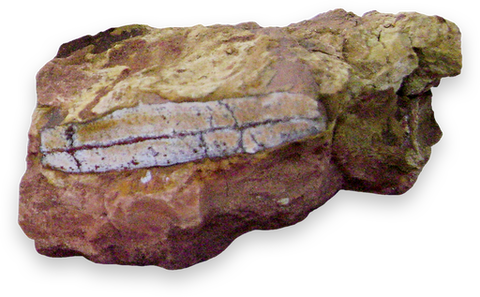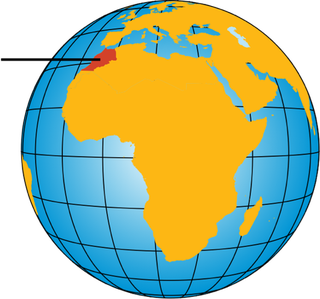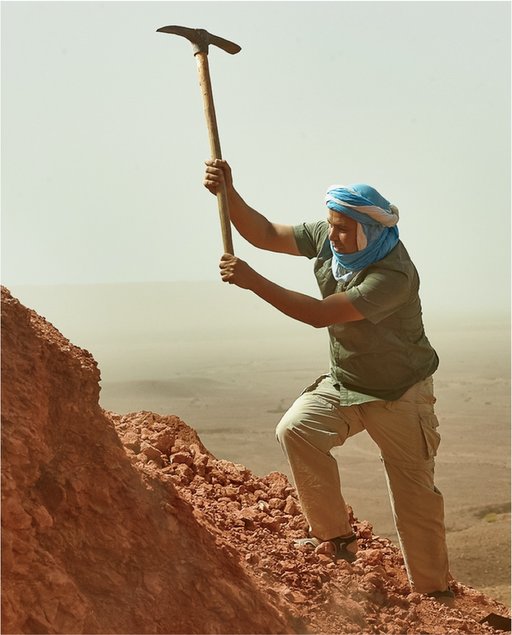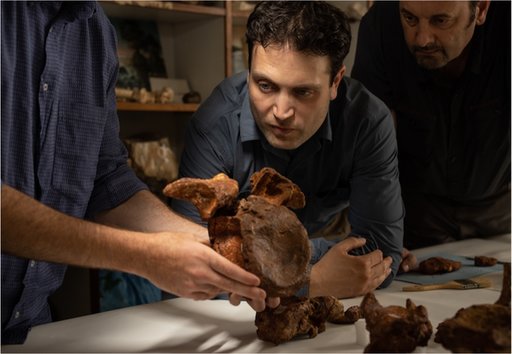
ThisfossilbecameanimportantcluetoNizarIbrahim’s search.
NizarIbrahimwasinasmalltowninMoroccoin2006.He’sapaleontologist— ascientistwhostudiesfossils.He’salsoaNationalGeographic Explorer.
HejustfinishedcollectingfossilsinthenearbySahara.HewasabouttoleaveMoroccoandheadhometostudythem.Butbeforeheleft,hewantedtotalktosomeofthelocalfossilhunters.Hewonderedifanyofthemhadfoundfossilsthatmightprovidecluestothefossilshehad found.

AFRICA
Morocco

boxesoffossilsfoundin Morocco
Ibrahimwasapproachedbyamanwhohadaboxoffossilshehadcollected.Themanhadamustache.Ibrahimwasmoreinterestedinwhatwasintheboxthantheman.Hehadnowayofknowingthattheman’smustachewouldbecomeveryimportanttothisstory later.
Theboxwasfull,butonefossilcaughttheexplorer’seye.Itwaslongandflat.Hehadneverseenonelikeitbefore.Hethoughtthatitmightbepartofaspineorarib.Hewasn’tsure.Hethoughtitmightbeimportant,soheboughtthe box.
Afterthesale,themanwiththemustachedisappeared.YearswouldpassbeforeIbrahimthoughtaboutthisfossilorthemanagain.Yet,thatfossilwouldleadhimonanamazingjourney.Intheend,hewoulddiscoveroneoftheoddestdinosaursthatever lived.

Ibrahimusedthefossilsthathadbeenfoundtopiecetogetheranunknown dinosaur.
PicturingthePast
Ibrahimhasmadedinosaurshislife’swork.HeoftentravelstotheSaharatolookforfossilizedbones.Ibrahimusesthescientificprocesstopiecetogetherthepast.Hestudiesthebonesandobservestheshapeofthebonesandwheretheyarefound,andhethinksaboutwhatpartoftheanimaltheycamefrom.Heaskskeyquestionstoformahypothesis, orexplanation,forhowtheseancientanimalsusedto live.
Toothers,theSaharamightlookwindy,desolate,anddry.Yet,whenIbrahimlooksoutacrossthedesert,heseessomethingelse.Hepictureswhatthisplacelookedlike95millionyearsago.Insteadofsand,heseesriversandswampsteemingwithlife.Thereweregiantturtles,hugecrocodiles,andfishthesizeofcars.Here,flyingreptilesfilledthesky.Threeoftheworld’slargestmeat-eatingdinosaurswalkedon land.

SearchingforSpinosaurustookhardworkand perseverance.

IbrahimandteammembersstudypartofthetailofSpinosaurus.
SomethingUrgent
Oneday,IbrahimreceivedamessagefromsomepaleontologistsinItaly.ThesefriendsdescribedanumberoffossilstheyhadseenthattheythoughtIbrahimwouldwanttosee, too.
Whenhearrived,severalfossilswerelaidoutforhiminthebasementofamuseum.Theywerelong,flatbones.HisfriendsthoughtthebonesmayhavecomefromMorocco.Theseboneslookedfamiliar.Theylookedalotlikethefossilheboughtfromthestrangerwiththemustacheyears ago.
ThesebonesremindedIbrahimofsomethingelse,too.Theyremindedhimofsomedrawingsandphotosofadinosaurthathehadseeninabookwhenhewasachild.Couldthesethingsbeconnected?Ibrahimwasbeginningtoformanew hypothesis.
ADifferentDinosaur
ThebonesIbrahimrememberedfromthebookhadbeendiscoveredbyaGermanscientist.Hehaduncoveredtheseunusualdinosaurbonesinthe Sahara.
ThisdinosaurwasbiggerthanT.rex.Ithadlongjawsandsharpteethshapedlikecones.Italsohadahugesailonitsback.ThescientistnameditSpinosaurus.
OnlytwopartialskeletonsofSpinosaurushadeverbeenfound.AmuseuminGermanyputthemondisplay,buttheyweredestroyedduringWorldWarII.Onlythescientist’snotesandoldphotos remained.
IbrahimthoughthisfossilandtheonesinItalymightbefromSpinosaurus, butheneededproof.Heneededmorebones.HewouldhavetoreturntoMorocco.Hewouldhavetofindthemanwiththe mustache.